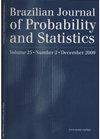一维KPZ方程的两点函数
IF 0.5
4区 数学
Q4 STATISTICS & PROBABILITY
引用次数: 1
摘要
在这篇简短的交流中,我们展示了Malliavin微积分的基本工具可以应用于从任意双侧布朗运动开始,根据与随机热方程相关的聚合物终点退火分布,导出一维KPZ方程斜率的两点函数。我们还证明了这种分布是根据KPZ方程解的方差导数给出的。本文章由计算机程序翻译,如有差异,请以英文原文为准。
On the two-point function of the one-dimensional KPZ equation
In this short communication we show that basic tools from Malliavin calculus can be applied to derive the two-point function of the slope of the one-dimensional KPZ equation, starting from an arbitrary two-sided Brownian motion, in terms of the polymer end-point annealed distribution associated to the stochastic heat equation. We also prove that this distribution is given in terms of the derivative of the variance of the solution of the KPZ equation.
求助全文
通过发布文献求助,成功后即可免费获取论文全文。
去求助
来源期刊

Brazilian Journal of Probability and Statistics
STATISTICS & PROBABILITY-
CiteScore
1.60
自引率
10.00%
发文量
30
审稿时长
>12 weeks
期刊介绍:
The Brazilian Journal of Probability and Statistics aims to publish high quality research papers in applied probability, applied statistics, computational statistics, mathematical statistics, probability theory and stochastic processes.
More specifically, the following types of contributions will be considered:
(i) Original articles dealing with methodological developments, comparison of competing techniques or their computational aspects.
(ii) Original articles developing theoretical results.
(iii) Articles that contain novel applications of existing methodologies to practical problems. For these papers the focus is in the importance and originality of the applied problem, as well as, applications of the best available methodologies to solve it.
(iv) Survey articles containing a thorough coverage of topics of broad interest to probability and statistics. The journal will occasionally publish book reviews, invited papers and essays on the teaching of statistics.
 求助内容:
求助内容: 应助结果提醒方式:
应助结果提醒方式:


